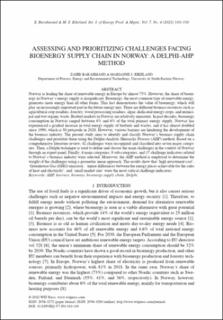| dc.description.abstract | Norway is leading the share of renewable energy in Europe by almost 75%. However, the share of bioenergy in Norway’s energy supply is insignificant. Bioenergy, the most common type of renewable energy, generates more energy than all other forms. This fact demonstrates the value of bioenergy, which will play an increasingly important part in the future energy mix. There are different biomass resources such as agricultural crop residues, forestry, wood processing residues, algae, dedicated energy crops, and municipal and wet organic waste. Biofuel markets in Norway are relatively immature. In past decades, bioenergy consumption in Norway ranged between 4% and 6% of the total primary energy supply. Norway has experienced a gradual increase in total energy supply of biofuels and wastes, and it has almost doubled since 1990, which is 80 petajoule in 2020. However, various barriers are hindering the development of the biomass industry. The present study aims to identify and classify Norway’s biomass supply chain challenges and prioritize them using the Delphi-Analytic Hierarchy Process (AHP) method. Based on a comprehensive literature review, 42 challenges were recognized and classified into seven major categories. Then, a Delphi technique is used to define and choose the main challenges in the context of Norway through an expert panel. Finally, 4 main categories, 9 sub-categories, and 37 challenge indicators related to Norway’s biomass industry were selected. Moreover, the AHP method is employed to determine the weight of the challenges using a geometric mean approach. The results show that ‘high investment cost’, ‘Greenhouse Gas (GHG) emission’, ‘minor differences between the energy prices achievable for the sales of heat and electricity’, and ‘small market size’ were the most critical challenge indicators. | en_US |
